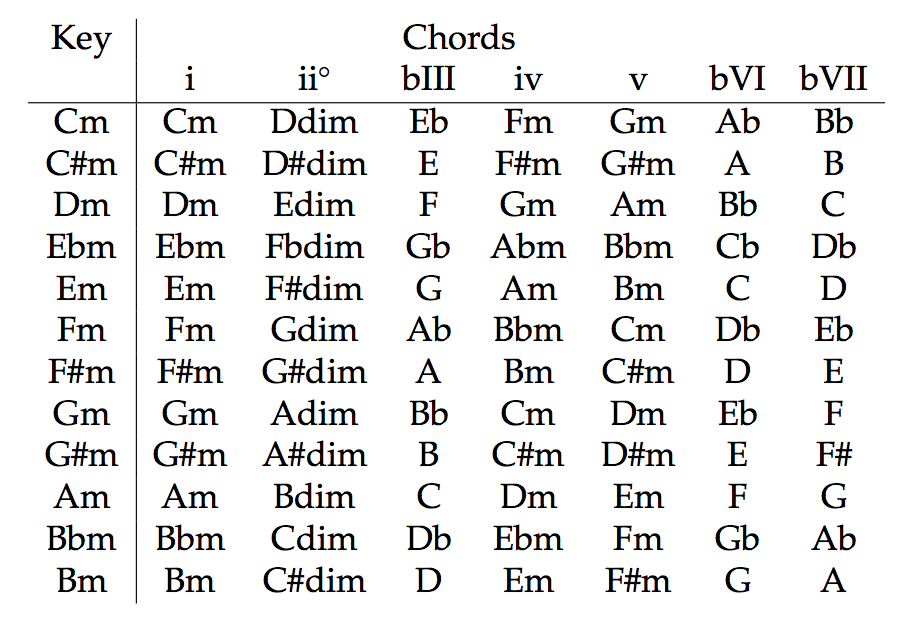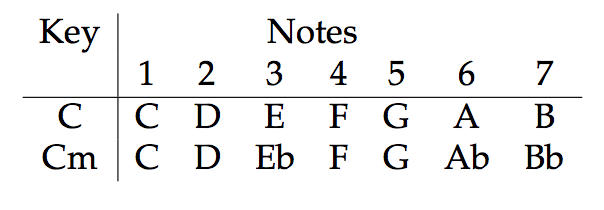The Chords of the Minor Scale
On a previous lesson we have seen how to play the natural minor scale on the guitar. Today instead we will have a look at the chords associated with the minor scale and how to use them to compose your own songs.
Chord Structure
Exactly like the major scale, any minor scale is associated with a set of seven chords - three major, three minor, one diminished. On the other hand, the order of these chords in the natural minor scale is different than it was for the major scale. The following points still hold true:
- The chords from a scale are strictly related with the notes on a scale; an A minor scale is made by the notes A B C D E F G (see our previous lesson on that, linked above). The chords associated with the A minor scale are A minor, B diminished, C major, D minor, E minor, F major, G major. In other words, every note in the scale is associated with a chord.
- The chord structure for the minor scale is the same for all keys. With this I mean that the order in which the major and minor chords appear is always the same. The first note of a minor key is always associated with a minor chord, the second note always with a diminished chord, and so on.
As I did for the major scale, I compiled for you a table with all the chords for every minor key. Here it is:

As you can see, some of the chord numerals, on the first row of the table, have a flat sign in front. In particular, the 3rd, 6th, and 7th chords are marked with the flat sign. Why is that? Well, to understand it you have to know that everything in music theory is written in respect to the major scale, not the minor scale. Let me explain this with an example. Here are the notes for the C major and C minor scale:

As you see, the 3rd, 6th, and 7th notes in the minor scale are “flatted” respect to the major scale. The chords symbols just refer to this fact, warning us that their root notes are lower than what we would expect from a major scale. In other words, with the symbol III we would indicate an E major chord, so we need to specify the flat in front of it as bIII to indicate the Eb chord.
Random Composition
Most of the time a chord progression in a minor key will start and end on the first chord of the key (i.e. a progression in C minor will usually start and end on C minor). The first chord will always sound “final” in all keys.
With the exception of the diminished chord (which has some special ways to use it, and so we will ignore it for the time being), the chords in a key can be played one after the other in any order and they will sound good.
All of this means that, as in the major scale, we can compose a song just by starting and ending on the first chord of a key and using other chords from the same key in random order.
- Throw a dice 3 times and write the resulting numbers down. As an example, let’s assume that you got 6,2,4.
- Start with the first chord in the key (in the key of C minor the first chord is C minor).
- Look at the first number you got from the dice. If this number is 1, then you use the first chord. Otherwise you need to add 1 to the number, then take the corresponding chords. Our first number is 6, we add one to get 7, so we get the 7th chord (Bb)
- Do the same for the other numbers. We obtain the chord progression Cm Bb Eb Gm.
The chord progression we just found is a bit difficult to play on the guitar, due to the fact that all these chords are bar chords. We can make it simpler by keeping the same numbers but using a different key. The same progression (i bVII bIII v) in the key of Am becomes Am G C Em, which is way easier to play. One of the important principles in music theory is that as long as the numbers of the chords are the same, you can change key and the progression will sound the same, just higher or lower in pitch.
If you want to learn everything there is to know about composing in the minor scales and in the related modes (scales that sound similar, but not the same as the minor scale), then click the button below and learn everything about guitar modes.
